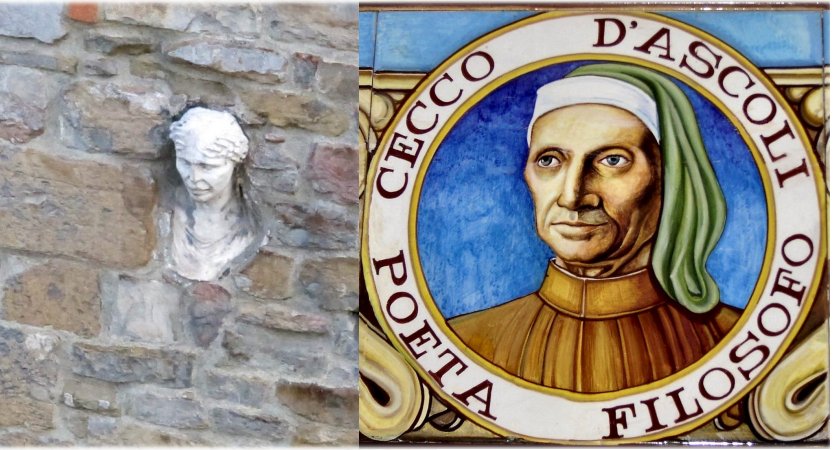Mysterious La Berta – ‘Petrified’ Stone Head And The Curse Of Cecco d’Ascoli Who Was Burned At The Stake
Ellen Lloyd - AncientPages.com - If you pass the old Church of Santa Maria Maggiore in Florence, Italy you may not even notice La Berta, but she is there, looking down at you. The mysterious stone head of an unknown woman has been part of the Church for as long as anyone can remember, but it’s still unknown who she once was.
Local legends tell the “petrified head” embedded in the bricks can be traced to a nasty event that took place on September 16, 1327.
The Curse Of Cecco d’Ascoli
On this particular day, Cecco d’Ascoli (1257 – 1327) was going to be burned at the stake for heresy. The man who was an accomplished scientist was passing the crowds of people who had gathered on the streets to witness the event. Many were standing on balconies eager to see the execution.
Left: Head of La Berta - Credit: Sailko, CC BY 2.5 - Right: Cecco d'Ascoli - Credit: annidiargento.it
When Cecco d’Ascoli was in front of the Church of Santa Maria Maggiore he asked for water, but at the very moment, a woman named Berta looked through the window and told the guards not to give the death-sentenced man any water. Not only did she deny him water, but she also accused him of being an alchemist who communicated with the Devil using water. She said that if Cecco d’Ascoli was given water, the Devil could grant him immunity. Of course, superstitious guards who heard this decided to follow the advice of the woman and made certain the prisoner never received a drop of water.
Cecco d’Ascoli was furious and cast a curse on her shouting 'You will never lift your head from there!'
Cecco d’Ascoli – An Accomplished Renaissance Scientist Who Was Too Outspoken
This is also exactly what happened according to local legends. The petrified head of La Berta is still visible from a small slit of the bell tower of the Church of Santa Maria Maggiore, waiting to be released from the curse.
Cecco d’Ascoli, who was burned at the stake was an accomplished scientist, but his free-thinking and plain-speaking attitude gave him many enemies. He was an encyclopaedist, physician, mathematician, astrologer, and poet.
In 1322 he was made Professor of astrology at the University of Bologna, and d’Ascoli could have dedicated his life to studies, but he became involved in religious debates. During the Renaissance, people questioned almost anything, art, learning, kings, queens, and the Church. That was the beauty of the Renaissance, but it was also dangerous to come in trouble with the Church. Even the powerful Medici family who were patrons of Galileo Galilei were not as strong as the leaders of the Inquisition and they failed to protect him when Galileo was arrested.
Cecco d’Ascoli had no one who protected him from the Inquisition, and he certainly made a deadly mistake when he attempted to determine the Nativity of Christ by reading his horoscope. This along with other accusations led to his death sentence.
The head of La Berta is easy to miss. Credit: Credit: Sailko, CC BY 2.5
Returning back to the mysterious head of an unknown woman in the upper part of the bell tower of the Church of Santa Maria Maggiore, it should be mentioned there are other stories that could shed light on her identity.
According to one theory, the head is a memorial dedicated to the greengrocer who donated bells to the church so they could chime whenever the city gates would open or close. Yet another theory is that the head is a Roman sculpture, but we don’t know whom it depicts.
It’s not unusual that old Churches and monasteries in Italy are associated with strange tales of magic, curses, and incredible supernatural events. For example, many think the Abbey of San Galgano is shrouded in mystery because no one knows how a meter-long sword ended in solid rock there.
Written by Ellen Lloyd – AncientPages.com
Copyright © AncientPages.com All rights reserved. This material may not be published, broadcast, rewritten or redistributed in whole or part without the express written permission of AncientPages.com
Expand for referencesThorndike, Lynn (1934). History of Magic and Experimental Science, vol. 2. New York: MacMillan. pp. 953–4, 959.
More From Ancient Pages
-
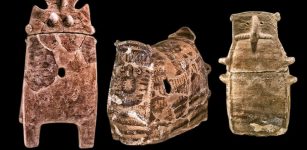 Blue Eyed People In Northern Israel 6,500 Years Ago: New DNA Results
Archaeology | Aug 22, 2018
Blue Eyed People In Northern Israel 6,500 Years Ago: New DNA Results
Archaeology | Aug 22, 2018 -
 Similarities And Differences Between Living Spaces Of Neanderthals And Homo Sapiens
Archaeology | Apr 9, 2024
Similarities And Differences Between Living Spaces Of Neanderthals And Homo Sapiens
Archaeology | Apr 9, 2024 -
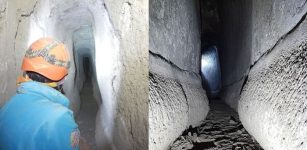 Giant Ancient Roman Underground Structure Discovered Near Naples, Italy – Aqua Augusta Investigated
Archaeology | Feb 6, 2023
Giant Ancient Roman Underground Structure Discovered Near Naples, Italy – Aqua Augusta Investigated
Archaeology | Feb 6, 2023 -
 DNA Study Of ‘Cheddar Man’ Re-Writes Ancient History Of Britain
Archaeology | Feb 9, 2018
DNA Study Of ‘Cheddar Man’ Re-Writes Ancient History Of Britain
Archaeology | Feb 9, 2018 -
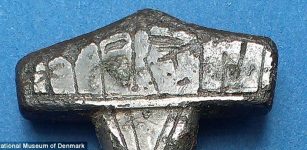 Remarkable Discovery Of Unusual “Hammer Of Thor” Finally Solves An Ancient Mystery
Archaeology | Jul 2, 2014
Remarkable Discovery Of Unusual “Hammer Of Thor” Finally Solves An Ancient Mystery
Archaeology | Jul 2, 2014 -
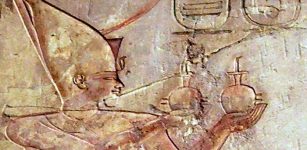 Newly Unearthed Colossal Statue Probably Depicts King Psammetich I And Not Ramses II
Archaeology | Mar 17, 2017
Newly Unearthed Colossal Statue Probably Depicts King Psammetich I And Not Ramses II
Archaeology | Mar 17, 2017 -
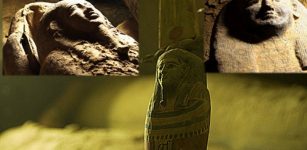 Collection Of 2,500 Years Old Sealed Coffins Unearthed In Saqqara, Egypt
Archaeology | Sep 8, 2020
Collection Of 2,500 Years Old Sealed Coffins Unearthed In Saqqara, Egypt
Archaeology | Sep 8, 2020 -
 Huge 1,400-Year-Old Hall Of The First Kings Of East Anglia Discovered In Rendlesham
Archaeology | Oct 5, 2022
Huge 1,400-Year-Old Hall Of The First Kings Of East Anglia Discovered In Rendlesham
Archaeology | Oct 5, 2022 -
 On This Day In History: Battle of Devil’s Hole Was Fought – On Sep 14, 1763
News | Sep 14, 2016
On This Day In History: Battle of Devil’s Hole Was Fought – On Sep 14, 1763
News | Sep 14, 2016 -
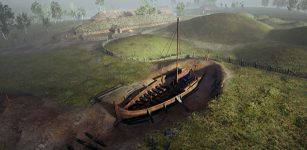 Archaeologists Reveal 12 Exciting Finds From The Gjellestad Viking Ship Dig
Archaeology | May 28, 2022
Archaeologists Reveal 12 Exciting Finds From The Gjellestad Viking Ship Dig
Archaeology | May 28, 2022 -
 New Light On Appearance Of Scythians In Northern Black Sea Region
Archaeology | Mar 11, 2017
New Light On Appearance Of Scythians In Northern Black Sea Region
Archaeology | Mar 11, 2017 -
 Unsolved Ancient Mystery Of Lost Pre-Olmec Civilization – Evidence Of Advanced Scientific Knowledge That Could Re-Write History
Ancient Mysteries | Jul 16, 2018
Unsolved Ancient Mystery Of Lost Pre-Olmec Civilization – Evidence Of Advanced Scientific Knowledge That Could Re-Write History
Ancient Mysteries | Jul 16, 2018 -
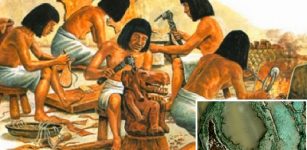 What Ancient Civilization Discovered Metallurgy?
Ancient Technology | Sep 19, 2017
What Ancient Civilization Discovered Metallurgy?
Ancient Technology | Sep 19, 2017 -
 Asgard: Enter The Ancient Kingdom Of The Powerful Norse Gods
Featured Stories | Aug 7, 2016
Asgard: Enter The Ancient Kingdom Of The Powerful Norse Gods
Featured Stories | Aug 7, 2016 -
 1,000-Year-Old Bone Skate Found In Moravian City Of Přerov, Czech Republic
Archaeology | Mar 20, 2024
1,000-Year-Old Bone Skate Found In Moravian City Of Přerov, Czech Republic
Archaeology | Mar 20, 2024 -
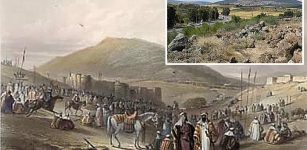 Ancient Thriving Market Of Khan al-Tujjar (The Merchants’ Caravanserai) Discovered In Lower Galilee
Archaeology | Feb 20, 2024
Ancient Thriving Market Of Khan al-Tujjar (The Merchants’ Caravanserai) Discovered In Lower Galilee
Archaeology | Feb 20, 2024 -
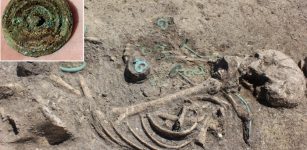 A Sensational Bronze Age Grave Of 20-Year-Old Elite Woman Found In Town Of Mány, Hungary
Archaeology | Aug 8, 2022
A Sensational Bronze Age Grave Of 20-Year-Old Elite Woman Found In Town Of Mány, Hungary
Archaeology | Aug 8, 2022 -
 Hidden Text Discovered On Dead Sea Scrolls Reveals An Unknown Manuscript Is Still Missing
Archaeology | May 5, 2018
Hidden Text Discovered On Dead Sea Scrolls Reveals An Unknown Manuscript Is Still Missing
Archaeology | May 5, 2018 -
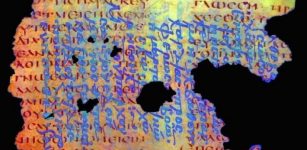 Never-Before-Seen Ancient Texts Hidden In Saint Catherine’s Monastery In Sinai Are Now Available Online
Archaeology | Dec 21, 2017
Never-Before-Seen Ancient Texts Hidden In Saint Catherine’s Monastery In Sinai Are Now Available Online
Archaeology | Dec 21, 2017 -
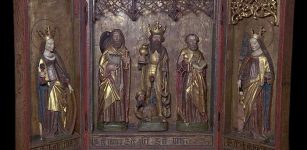 History Of Middle Ages Altarpieces Has Been Re-Written
Archaeology | Mar 10, 2018
History Of Middle Ages Altarpieces Has Been Re-Written
Archaeology | Mar 10, 2018

